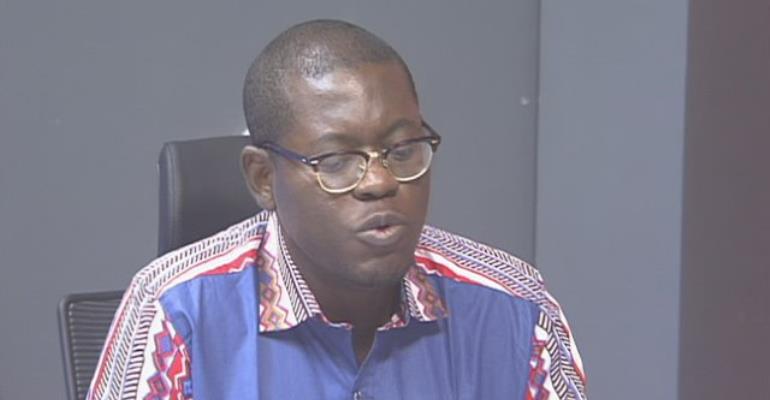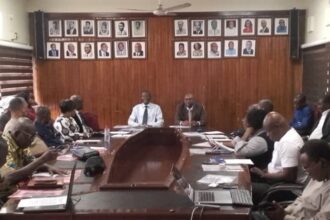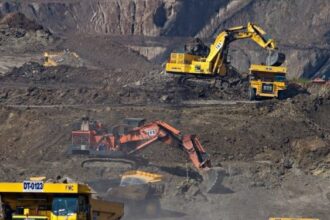Vice President of IMANI Africa Bright Simons has described as “fanciful” the $10 billion bauxite deal between the government of Ghana and Asian giants China.
According to him, the deal “will go nowhere.”
In a detailed analysis of the transaction, which is beyond the loan or barter, controversy engineered by the political class, Simons said the claim that Ghana’s bauxite reserve is valued at $460 billion could be misleading.
The Senior Minister in an interview with the BBC said “we are more than satisfied that this will benefit the ordinary Ghanaian because this will create employment for the ordinary Ghanaian. The creation of employment out of the exploitation of natural resources can only be beneficial to our people.
“…If you have $460 billion worth of item [bauxite] and you need $10 billion to access it and create employment in the region of about 100,000 then what you must be mindful of is the price at which you barter this product for the 10 billion,” Osafo Maafo said.
But in a four-page dissection of the Ghana-China bauxite barter deal, a copy of which was sent to Myjoyonline.com, Simons said any claim of a $460 billion bauxite reserve would mean the country has in excess of 8.7 billion tonnes of bauxite reserve which will make the country the leading producer of the mineral in the world, a proposition that is highly unlikely, he asserted.
The following is the full report;
Ghana’s “Bauxite Barter Deal” & the Billion-Dollar Confusion
There are reports in the Ghanaian press that the IMF has referred Ghana’s recently ratified Master Project Support Agreement with Sinohydro Corporation of China to its legal department for advice on whether what the Ghanaian government is calling a “barter agreement” should instead be classified as a loan.
Intrusive as that may sound, and an affront to Ghana’s sovereignty as some may rightly term the intrusion, it may well serve some use, considering the fact that the said agreement has not been made accessible on the website of the Ghanaian Parliament or any government website for that matter. Most analysts may just have to wait for the IMF’s legal opinion.
Luckily, for some of us, it is not the legalities that are of primary interest; it is, rather, the commercial and financial logic.
The “bauxite barter deal” between Ghana and Sinohydro is not actually very different from the cocoa deal that got the Bui dam built (an interesting point considering the current dispute over the eligibility of the “loan” categorisation). The same company, Sinohydro, by most measures the world’s largest dam construction company, is involved. Clearly, it is drawing on its experience in the Bui episode as it enters into this latest arrangement.
Whilst the general design of the two deals, resource-backed infrastructure financing, is the same, there is a world of difference, however, when one takes into account the level of complexity.
In the case of Bui, Sinohydro was operating in its sweet spot: dam construction. A single dam to be precise. Dams are revenue generating objects, and to underline that fact, an escrow account was set up so that proceeds from power sold to the Electricity Corporation of Ghana (ECG) could be channelled directly to offset part of the debt. Furthermore, the natural resource involved – cocoa – is a mature category in Ghana’s portfolio of assets. The buyer – Genertec – and the ultimate lender – China EXIM bank – could be assured of the volumes without much fuss (about 40,000 metric tonnes per annum, just about 5% of Ghana’s usual annual production).
The “bauxite barter” deal on the other hand is far more complicated.
In the first place, the actual resource being presented as security is not yet available. The Government of Ghana chose “alumina” instead of bauxite in order to improve the value of the security. The motivation is very easy to understand, at an 8% discount rate, Ghana would need to find bauxite worth $420 million a year over the 15-year life of the facility for the arrangement to make sense (assuming zero production costs, a subject we treat later). With Chinese landed bauxite prices hovering around the $53 mark for our type of bauxite, that would suggest about 8 million metric tonnes of bauxite a year. Ghana has been struggling to produce even 800,000 tonnes a year to date. The infrastructural investments required to triple this quantity by bringing the Atewa reserves into play are significant (assuming here that all bauxite produced into the country shall be handed over to the Chinese). Increasing the overall production by ten times, which is what would be needed were bauxite the resource collateral, is simply unrealistic for at least 8 more years.
Hence the focus on alumina. Sound pricing forecasts for alumina in the near-term indicate an average of about $550 per metric tonne. In essence, using a rough rule of thumb, 1 million tonnes of alumina requires just about 2.5 million tonnes of bauxite, in turn requiring that Ghana only triples its current production of bauxite (assuming, once again, that no bauxite shall be exported raw to any other country).
Tripling bauxite production should not be gut-wrenchingly difficult. All that is needed really are access roads, giant trucks, ore cleaning machines, and port storage facilities. At those volumes, rail investment can be deferred. We can be safe in the knowledge that with an estimate of $100 million in capital expenditure and $25 per tonne in operating costs we would be getting close to what is required to deliver our side of the bargain. That means that an upfront investment of about $125 million should be sufficient to unlock the $2 billion. Except of course that it won’t. We are not carefully accounting for the alumina refining component of the deal nor explaining who bears the operating costs for mining the bauxite.
If Sinohydro is to become responsible for the operating costs of mining the extra 1.8 to 2 million tonnes of bauxite we need to produce in Ghana in order to be able to refine the quantities of alumina needed to service the $2 billion facility, then it needs to find roughly $750 million to underwrite that expense (over a 15-year period). It seems obvious that this amount needs to be factored into the calculations somehow. That cost, carefully reviewed, is the cost of the bauxite that has to go into the alumina production.
Ghana’s bauxite is mainly gibbsite which, compared to trihydrates, consume significantly higher amounts of power during the process of conversion to alumina. That fact, compounded with scale factors and other complications, yields a production cost for alumina in the Ghana context of about $300 per tonne.
Thus whilst Ghana could easily make $550 million per annum producing 1 million tonnes of alumina after tripling its bauxite production, it needs to find about $1 billion in upfront investments, and account for running costs of about $300 million a year.
Two questions therefore arise: is Sinohydro investing this amount of one billion dollars separately from the $2 billion “barter” arrangement, or is this investment requirement factored into the $2 billion “barter deal”? If so, how come Ghana has tendered a laundry list of roads and hospitals worth $2 billion, out of which an initial tranche of $500 million is already due by the end of the year?
More critically how is Ghana going to fund the refinery costs of $300 million a year if all the inbound $2 billion is expended on roads and hospitals and no portion of the amount is amortised to assist with costs of production and maintenance? Recall that at an 8% discount rate, the average servicing costs for both principal and interest is about $420 million per annum (including provisioning for principal retirement). Should the sale of alumina yield $550 million per annum, the surplus recorded is only $130 million, not enough to keep the engines running. The situation is only saved if $170 million is available annually to cushion the financial model. To keep matters simple this analysis does not even take into account the 15% co-financing obligation of the government, another $300 million millstone.
But even if we have been overly stringent in our projections, it seems very likely that a substantial proportion of the $2 billion being borrowed is required just to support the underlying venture and thus uphold the security of the facility (i.e. to mine and refine the bauxite). It is hard to see how anything less than half of the amount will do. Unless Sinohydro is in the business of losing money, why would it guarantee $2 billion of loans from China EXIM Bank or other lenders for Ghana without factoring into the financial model somehow the costs of securing the natural resources needed to pay for the interest and principal? Unless the profit margins on the infrastructure it is to build are so large that it intends that ultimately Ghana gets far less than $1 billion of infrastructure for $2 billion worth of bauxite. This is after all, one giant sole-sourcing arrangement.
This discussion has centred only on the $2 billion package. As everyone now knows, the government plans to secure $10 billion overall. The analysis breaks down completely in the face of such audacity.
Much of the thinking propelling these bold borrowing plans is based on a misguided notion of zero-cost production. Firstly, there was a claim that Ghana has bauxite reserves valued at $460 billion, by none other than the Senior Minister himself. This implies 8.7 billion tonnes of proven bauxite reserves, making Ghana the owner of the world’s largest reserves, and with more than 25% of the global total. Obviously ridiculous.
Even the uncritical 960 million metric tonnes of bauxite reserves figure one hears often in government circles should translate to $50 billion in terms of historical average prices. If the $460 billion figure emanates from an assumption that all that bauxite shall be converted into alumina, then one wonders why we don’t assume that the bauxite shall be converted to aluminium, or even roofing sheets. The truth of course is that converting any part of that bauxite into alumina, aluminium or roofing sheets requires billions of dollars of investment, a prospect far from assured.
It is also instructive to point out that the 960 million tonnes of reserves number is based on wild guessing. Successive Ghanaian governments have to date refused or neglected to conduct any serious mineralogical surveys, with the sad result that most of the data used for estimation in these matters date back to the ‘70s and ‘80s and rely on half-baked datasets. The upper bound found in the only major Ghanaian geological survey of bauxite reserves to date was 580 million metric tonnes across thirteen main deposits. These were however not all proven. Proven reserves were in the order of about 370 million metric tonnes. This would suggest a valuation of about $20 billion.
One may be tempted to argue that resources worth $20 billion are still far more than needed to secure a $10 billion facility, after all it would suggest that Ghana is “leveraging” only 50% of one asset category for massive development. Unfortunately, it is not that simple. “Exploiting” reserves of any mineral, as we have seen in the preceding discussion, is a complex undertaking. Guinea for instance only produces about 0.5% of its total reserves per annum. Australia produces about 1.25%. Jamaica produces about 0.4%; and Vietnam, about 0.05%. If Ghana is successful in exploiting an incredibly high proportion of 5% (i.e. decide to consume all the bauxite it has in 20 years), it will immediately become the 6th largest producer in the world, overtaking Russia, Jamaica and Vietnam, all countries with reserves many many times the quantity of Ghana’s. This amount of production – 18.5 million tonnes a year – will still yield only about $500 million unless the country succeeds in converting most or all into alumina. Doing so will indeed yield about $4.6 billion per annum (a testament to the incredible shift of the bauxite-alumina value ratio from 6.5 to nearly 10 over the last decade). More than enough to securitise a $10 billion facility with a 15-year tenor. But it will require anything between $25 billion and $30 billion in upfront investments. And a considerable amount of environmental damage. None of which we can afford for at least a decade.
In short, the idea of using bauxite resources to secure $10 billion is fanciful, and will go nowhere. The $2 billion package is more realistic, but the undertaking needs considerably more work to ensure successful realisation within the term of this Ghanaian Administration, as well as value for money.
Source: Myjoyonline














